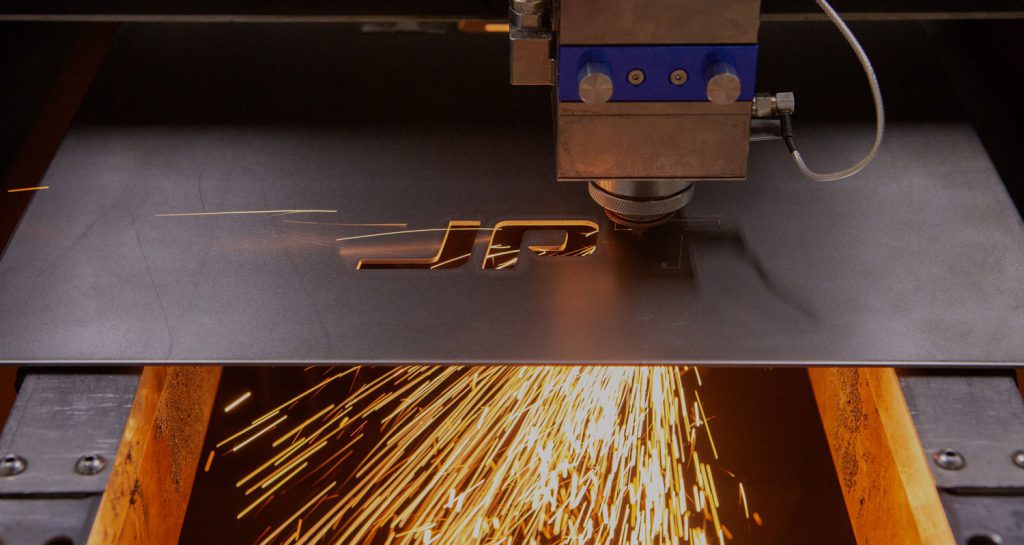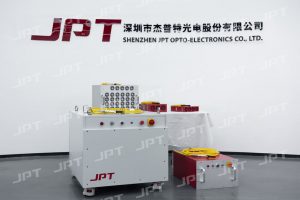Laser technology has been developed progressively over the past 60 years. It’s widely used in the field of traditional processing, for example, marking, welding, cutting, etc., and in the area of aero- space where applying advanced materials is the strategical demands.
Laser welding is a welding technique used to join pieces of metal or thermoplastics through the use of laser. It offers high- density beam on the surface of the material.
The instant energy melts the material and the material crystallizes after cooling down, by which two materials are tightly joined.
Compared with the conventional welding processes, laser welding has many advantages.
First, the grains crystal grows unidirectional due to the laser beam irradiation, and shows a very fine dendrite structure, which results in excellent mechanical properties.
In addition, laser welding shows much lower thermal stress and thermal effect due to the small laser beam size. Thus, it is more feasible to join refractory materials and dissimilar metals.
Besides, less harmful substances are generated during the welding fume. Furthermore, the abilities of anti-porosity and anti-crack are much better.
In the market, there are various types of lasers corresponding to different applications. Even focusing on laser welding, there are plenty of kinds of lasers for different welding methods.
In the following content, we focus on discussing the welding performance by using the MOPA ns pulsed fiber laser, QCW fiber laser, and YAG laser. The detailed parameters of these three types of lasers are shown in Table 1.
The used ns pulse fiber laser for welding evaluation is based on the MOPA structure, assembled by JPT with eight adjustable pulse width. The welding evaluation results shown below are based on the three lasers. Please feel free to contact us if you need any further information.
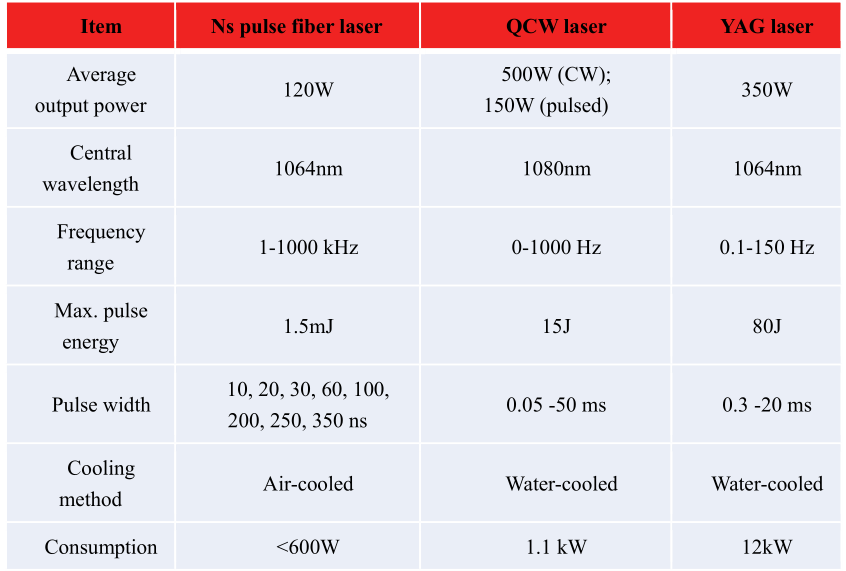
The following ( see Fig.1) is a rough idea about the welding test by applying different types of lasers (the ns pulse fiber laser, QCW fiber laser, and YAG laser).
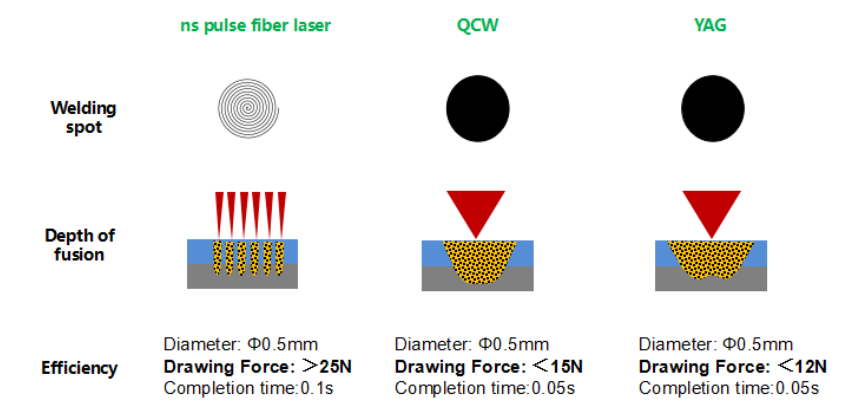
The focused beam diameter of ns pulse fiber laser is smaller than those of the QCW and YAG lasers. The welding spots for the QCW and YAG lasers are generated by using one emission, while the welding spot for the ns pulse fiber laser is spiral so that its size could be close to the other two types lasers’.
The pulse energy is 1.5 mJ for ns pulse fiber laser, and it is 15 J for the QCW and YAG lasers. Therefore, it will take longer time for the pulse fiber laser to get the same-size welding spot.
Observing the cross-section, the bath is serrated by using the ns pulsed fiber laser and they are hollow by using the QCW and YAG lasers.
Besides, the beam quality of the QCW laser is much better than the YAG’s. Thus the cross-section is close to cone-shape by using the QCW laser.
Firstly, we carried out the welding test on the steel by using the ns pulse fiber laser and QCW laser. Fig. 2a shows the 3D profile of the molten pool which is different due to the different welding principles.
By using the ns pulse fiber laser, the welding spot is spiral and the molten pool is more uniform. And the result shows the drawing force is more significant.
However, the thermal effect is much smaller by using the QCW fiber laser due to short interaction time. The welding spot is generated by one emission and the molten pool is close to a cone.
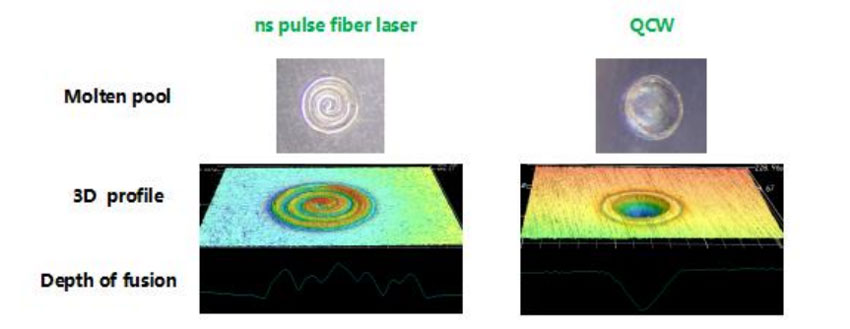
Secondly, we also evaluated the welding performance for the dissimilar material (weld the copper on steel) by using the ns pulse fiber laser and QCW laser. Fig. 2b shows detailed results for the metallographic examination.
The aspect ratio of the welding area used by the QCW laser is close to 1:1 while the drawing force is more significant for the ns pulse fiber laser.
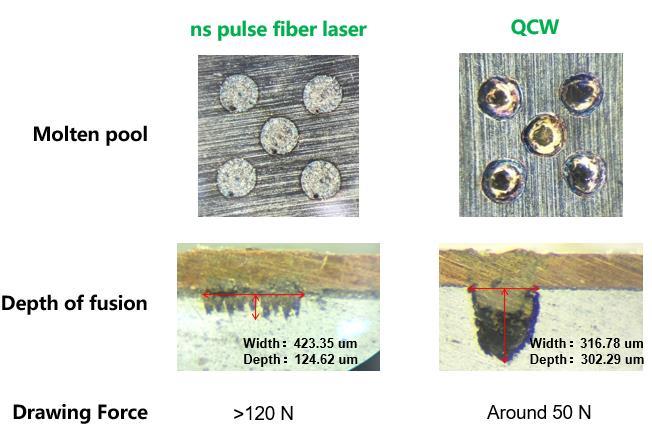
The welding performance is different for different types of lasers. Table 2 summarized the results of the welding evaluation for the three laser models. For dissimilar metal welding, especially for thin materials, the ns pulse fiber laser is suggested.
It requires a delicate balance between melt and vaporization. The energy has to be sufficient to melt the material, but not able to vaporize the material.
The MOPA structure for welding is benefited from its flexibility pulse control. We tested various dissimilar thin metals, for example, brass-steel, titanium-steel, aluminum-brass, brass- copper, etc.
Besides, for the welding in 3C products, the ns pulsed fiber laser is widely used because the precise process can be satisfied.
Due to the well-controlled beam quality for QCW fiber lasers, the performance of the spot finishing, thermal effect, and welding surface is better compared with YAG laser.
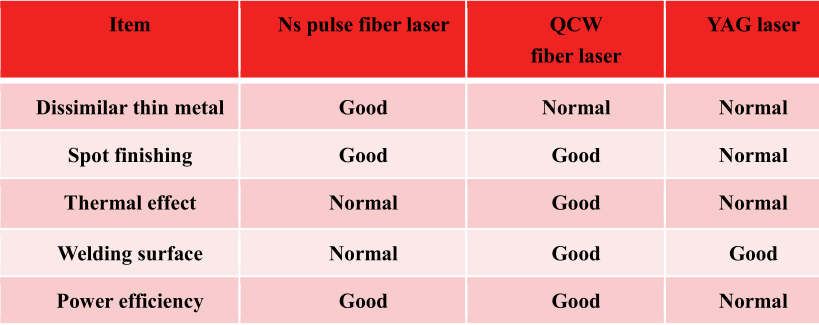
A proper laser leads to a higher success rate for specific welding applications.
JPT owns a specialized application lab with highly trained engineers and various types of equipment used for different applications (marking, cutting, welding, etc.), which helps customers to evaluate the processing characteristics before choosing the appropriate laser.
You are welcome to contact us anytime for any questions.
You May Also Like

HiPA Solutions – Laser Micro Hole Drilling
Flexible circuit boards, referred to as FPC are widely used in consumer electronic products such as microelectronics, 5G mobile phones, laptop computers, and new energy vehicles. Also as electronic interconnects to connect products.
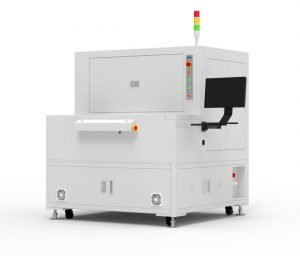
HiPA Solutions – Laser Ink Removal
Ink is an important material for printing. By printing or inkjet, patterns and characters are displayed on the substrate. Among them, screen printing inks are widely used on the cover glass of various display panels such as mobile phones, computers, smart watches, cameras, etc.

JPT Solutions – Thick Glass Cutting with Ultrafast Laser
Table of Contents Applied Industry Because of its excellent optical properties and unique wear resistance, cover glass is used in automotive display screens. The continuous
- HiPA Solutions – Laser Micro Hole Drilling - 09/12/2022
- HiPA Solutions – Laser Ink Removal - 03/12/2022
- JPT Solutions – Thick Glass Cutting with Ultrafast Laser - 03/12/2022
